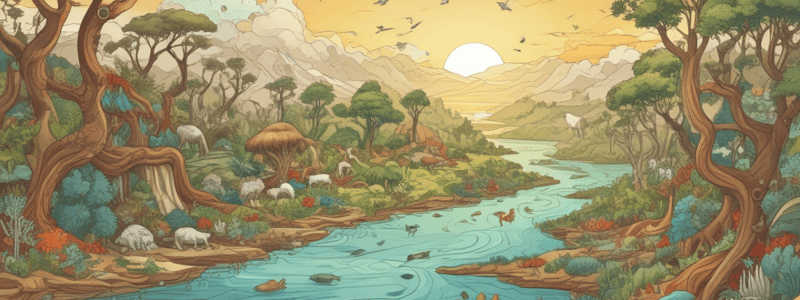Podcast
Questions and Answers
Which nutrient is often a limiting factor in streams, lakes, and freshwater environments?
Which nutrient is often a limiting factor in streams, lakes, and freshwater environments?
- Oxygen
- Phosphorus (correct)
- Potassium
- Nitrogen
Which component of fertilizers benefits crop growth in poor soil by providing an essential element for plant development?
Which component of fertilizers benefits crop growth in poor soil by providing an essential element for plant development?
- Magnesium
- Calcium
- Nitrogen (correct)
- Sulfur
What process have German chemists developed that affects the global nitrogen cycle?
What process have German chemists developed that affects the global nitrogen cycle?
- Increasing atmospheric nitrogen levels
- Reducing nitrogen emissions from industrial processes
- Decreasing nitrogen fixation by plants
- Transforming nitrogen gas into usable forms for fertilizer (correct)
Why is phosphorus essential for living organisms?
Why is phosphorus essential for living organisms?
What is a nutrient called that limits productivity when in short supply?
What is a nutrient called that limits productivity when in short supply?
Which type of primary producer uses chemical energy to produce carbohydrates?
Which type of primary producer uses chemical energy to produce carbohydrates?
Which of the following categories of consumers is involved in the chemical breakdown of organic matter?
Which of the following categories of consumers is involved in the chemical breakdown of organic matter?
Which type of consumer consumes both plant and animal matter?
Which type of consumer consumes both plant and animal matter?
In what way do autotrophs primarily obtain their energy?
In what way do autotrophs primarily obtain their energy?
Which type of consumer specifically chews or grinds detritus into smaller pieces?
Which type of consumer specifically chews or grinds detritus into smaller pieces?
Which group of organisms is most likely to engage in chemosynthesis?
Which group of organisms is most likely to engage in chemosynthesis?
Which of the following processes in the carbon cycle is responsible for removing carbon dioxide from the atmosphere?
Which of the following processes in the carbon cycle is responsible for removing carbon dioxide from the atmosphere?
What is formed when dissolved carbon dioxide in oceans combines with calcium and magnesium?
What is formed when dissolved carbon dioxide in oceans combines with calcium and magnesium?
Which process in the nitrogen cycle converts nitrogen gas into ammonia?
Which process in the nitrogen cycle converts nitrogen gas into ammonia?
What is the role of bacteria in the process of denitrification?
What is the role of bacteria in the process of denitrification?
How does human activity impact the carbon cycle?
How does human activity impact the carbon cycle?
Which of the following are products or results of natural geological processes in the carbon cycle?
Which of the following are products or results of natural geological processes in the carbon cycle?
Which of the following is NOT a cycle that carries vital nutrients through the environment?
Which of the following is NOT a cycle that carries vital nutrients through the environment?
What is a common factor between biological and chemical processes in the carbon cycle?
What is a common factor between biological and chemical processes in the carbon cycle?
What percentage of energy available within one trophic level is typically transferred to the next trophic level?
What percentage of energy available within one trophic level is typically transferred to the next trophic level?
Which of the following models plots the relative number of living organisms in each trophic level?
Which of the following models plots the relative number of living organisms in each trophic level?
Which of the following processes is NOT considered part of the biogeochemical processes?
Which of the following processes is NOT considered part of the biogeochemical processes?
During which stage of the water cycle does water become groundwater?
During which stage of the water cycle does water become groundwater?
What is the primary way in which groundwater is released back into the atmosphere?
What is the primary way in which groundwater is released back into the atmosphere?
Which element is NOT part of the biogeochemical cycles as mentioned?
Which element is NOT part of the biogeochemical cycles as mentioned?
What process is included in physical and chemical processes but not in biogeochemical processes?
What process is included in physical and chemical processes but not in biogeochemical processes?
What is the flow of energy between trophic levels an example of?
What is the flow of energy between trophic levels an example of?
Which of the following statements best describes a food chain?
Which of the following statements best describes a food chain?
What primarily causes the conversion of dead material into nutrients useful to primary producers?
What primarily causes the conversion of dead material into nutrients useful to primary producers?
Why is there a loss of energy and matter at each trophic level in a food web?
Why is there a loss of energy and matter at each trophic level in a food web?
Which concept illustrates the interconnectedness of different food chains in an ecosystem?
Which concept illustrates the interconnectedness of different food chains in an ecosystem?
What is the role of decomposers in an ecosystem's energy flow?
What is the role of decomposers in an ecosystem's energy flow?
How are food webs affected by environmental changes?
How are food webs affected by environmental changes?
What is an ecological pyramid?
What is an ecological pyramid?
Which of the following statements about energy levels in a trophic pyramid is correct?
Which of the following statements about energy levels in a trophic pyramid is correct?
Flashcards are hidden until you start studying
Study Notes
Energy Flow in Ecosystems
- Energy flows through an ecosystem in one direction, from primary production to various consumers.
- A food chain is a series of organisms in which energy is transferred from one organism to another.
- Food webs are networks of interconnected food chains, showing the overall flow of energy and matter through an ecosystem.
- Energy and matter are lost at each level of feeding, with decomposers playing a crucial role in recycling nutrients.
Ecological Pyramids
- Ecological pyramids model the relative amounts of energy or matter contained within each trophic level in a food chain or food web.
- The pyramid of energy shows that only a small portion of energy is available to organisms at the next trophic level.
- On average, 10% of energy is transferred to the next trophic level.
- Pyramids of biomass and numbers measure the total amount of living tissue and the relative number of living organisms in each trophic level, respectively.
Cycles of Matter
- Matter flows between trophic levels of a system and among ecosystems through recycling, biogeochemical processes, physical and chemical processes, and human activities.
- The water cycle involves the circulation of water among the hydrosphere, atmosphere, and geosphere.
- Nutrients are essential for life and circulate through organisms and the environment through biogeochemical cycles.
Nutrients and Cycles
- The carbon cycle involves the exchange of carbon dioxide between the atmosphere, oceans, and land through biological, geological, chemical, and physical processes, as well as human activities.
- The nitrogen cycle involves the conversion of nitrogen gas into ammonia and nitrates through natural processes and human activities such as industrial fertilization.
- The phosphorus cycle involves the cycling of phosphorus through the environment, with phosphorus being essential for life but not cycling through the atmosphere.
Primary Producers and Consumers
- Primary producers are autotrophs that capture energy from nonliving sources and convert it into forms living cells use.
- Energy from the sun is used by algae and plants to build living tissues through photosynthesis.
- Chemosynthesis is a process used by bacteria to produce energy in the absence of light.
- Consumers are heterotrophs that acquire energy from other organisms, and can be classified into different types such as carnivores, scavengers, decomposers, detritivores, herbivores, and omnivores.
Studying That Suits You
Use AI to generate personalized quizzes and flashcards to suit your learning preferences.



